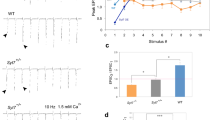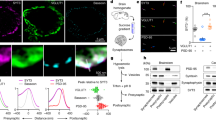Abstract
AT many synapses, the amount of transmitter released by action potentials increases progressively during a train of spikes. This enhancement of evoked transmitter release grows during tetanic stimulation with several time constants, each bearing a different name (facilitation: tens to hundreds of milliseconds; augmentation: several seconds; potentiation: several minutes), and the enhance-ment of release to test spikes after a tetanus decays with similar time constants. All these processes depend on presynaptic Ca2 + influx during the conditioning tetanus1. It has often been proposed that these forms of synaptic plasticity are due to residual Ca2 + present in nerve terminals following conditioning activity2. We tested this idea directly by using photolabile Ca2 + chelators to reduce residual Ca2 * following conditioning stimulation or to gen-erate an artificial elevation in Ca2 + concentration, and observed the effects on synaptic transmission at crayfish neuromuscular junctions. We found that facilitation, augmentation and potentia-tion are caused by the continuing action of residual Ca2 +. Augmen-tation and potentiation seem to arise from Ca2 + acting at a separate site from facilitation, and these sites are different from the molecular target triggering neurosecretion.
This is a preview of subscription content, access via your institution
Access options
Subscribe to this journal
Receive 51 print issues and online access
$199.00 per year
only $3.90 per issue
Buy this article
- Purchase on Springer Link
- Instant access to full article PDF
Prices may be subject to local taxes which are calculated during checkout
Similar content being viewed by others
References
Zucker, R. S. A. Rev. Neurosci. 12, 13–31 (1989).
Magleby, K. L. & Zengel, J. E. J. gen. Physiol. 80, 613–638 (1982).
Adams, S. R., Kao, J. P. Y. & Tsien, R. Y. J. Am. Chem. Soc. 111, 7957–7968 (1989).
Delaney, K. R., Zucker, R. S. & Tank, D. W. J. Neurosci. 9, 3558–3567 (1989).
Delaney, K. R. & Tank, D. W. J. Neurosci. (in the press).
Mulkey, R. M. & Zucker, R. S. J. Neurosci. 12, 4327–4336 (1992).
Zucker, R. S. Cell Calcium 13, 29–40 (1992).
Kaplan, J. H. & Ellis-Davies, G. C. R. Proc. natn. Acad. Sci. U.S.A. 85, 6571–6575 (1988).
Zucker, R. S. Cell Calcium 14, 87–100 (1993).
Minta, A., Kao, J. P. Y. & Tsien, R. Y. J. biol. Chem. 264, 8171–8178 (1989).
Mulkey, R. M. & Zucker, R. S. J. Physiol. Lond. 462, 243–260 (1993).
Landò, L. & Zucker, R. S. J. Neurophysiol. 72, 825–830 (1994).
Swandulla, D., Hans, M., Zipser, K. & Augustine, G. J. Neuron 7, 915–926 (1991).
Yamada, W. M. & Zucker, R. S. Biophys. J. 61, 671–682 (1992).
Bittner, G. D. & Schatz, R. A. Brain Res. 210, 431–436 (1981).
Bain, A. I. & Quastel, D. M. J. J. Physiol., Lond. 455, 383–405 (1992).
Zengel, J. E. & Magleby, K. L. J. gen. Physiol. 76, 175–211 (1980).
Zengel, J. E. & Magleby, K. L. J. gen. Physiol. 77, 503–529 (1981).
Tanabe, N. & Kijima, H. Neurosci. Lett. 99, 147–152 (1989).
Delaney, K., Tank, D. W. & Zucker, R. S. J. Neurosci. 11, 2631–2643 (1991).
Hochner, B., Parnas, H. & Parnas, I. Neurosci. Lett. 125, 215–218 (1991).
Robitaille, R. & Charlton, M. P. Annls N.Y. Acad. Sci. 635, 492–494 (1991).
Tanabe, N. & Kijima, H. J. Physiol., Lond. 455, 271–289 (1992).
Van der Kloot, W. & Molgó, J. J. Neurophysiol. 69, 717–729 (1993).
Adler, E. M., Augustine, G. J., Duffy, S. N. & Charlton, M. P. J. Neurosci. 11, 1496–1507 (1991).
Van der Kloot, W. J. Neurosci. 14, 5722–5724 (1994).
Bennett, M. K. & Scheller, R. H. A. Rev. Biochem. 63, 63–100 (1994).
Llinás, R., Gruner, J. A., Sugimori, M., McGuiness, T. L. & Greengard, P. J. Physiol., Lond. 436, 257–282 (1991).
Zucker, R. S. J. Physiol., Lond. 241, 91–110 (1974).
Regehr, W. G., Delaney, K. R. & Tank, D. W. J. Neurosci. 14, 523–537 (1994).
Author information
Authors and Affiliations
Rights and permissions
About this article
Cite this article
Kamiya, H., Zucker, R. Residual Ca2 + and short-term synaptic plasticity. Nature 371, 603–606 (1994). https://doi.org/10.1038/371603a0
Received:
Accepted:
Issue Date:
DOI: https://doi.org/10.1038/371603a0
This article is cited by
-
Histamine H3 Receptor Activation Modulates Glutamate Release in the Corticostriatal Synapse by Acting at CaV2.1 (P/Q-Type) Calcium Channels and GIRK (KIR3) Potassium Channels
Cellular and Molecular Neurobiology (2022)
-
Presenilins regulate synaptic plasticity and mitochondrial calcium homeostasis in the hippocampal mossy fiber pathway
Molecular Neurodegeneration (2017)
-
The calcium sensor synaptotagmin 7 is required for synaptic facilitation
Nature (2016)
-
Glutamate Release
Neurochemical Research (2015)
-
Modulation of Hippocampal Synaptic Transmission by the Kynurenine Pathway Member Xanthurenic Acid and Other VGLUT Inhibitors
Neuropsychopharmacology (2013)
Comments
By submitting a comment you agree to abide by our Terms and Community Guidelines. If you find something abusive or that does not comply with our terms or guidelines please flag it as inappropriate.



